08 Sep November 2018
Willis Sinclair Homes
“The Lowcountry’s Premier Custom Home Builder”
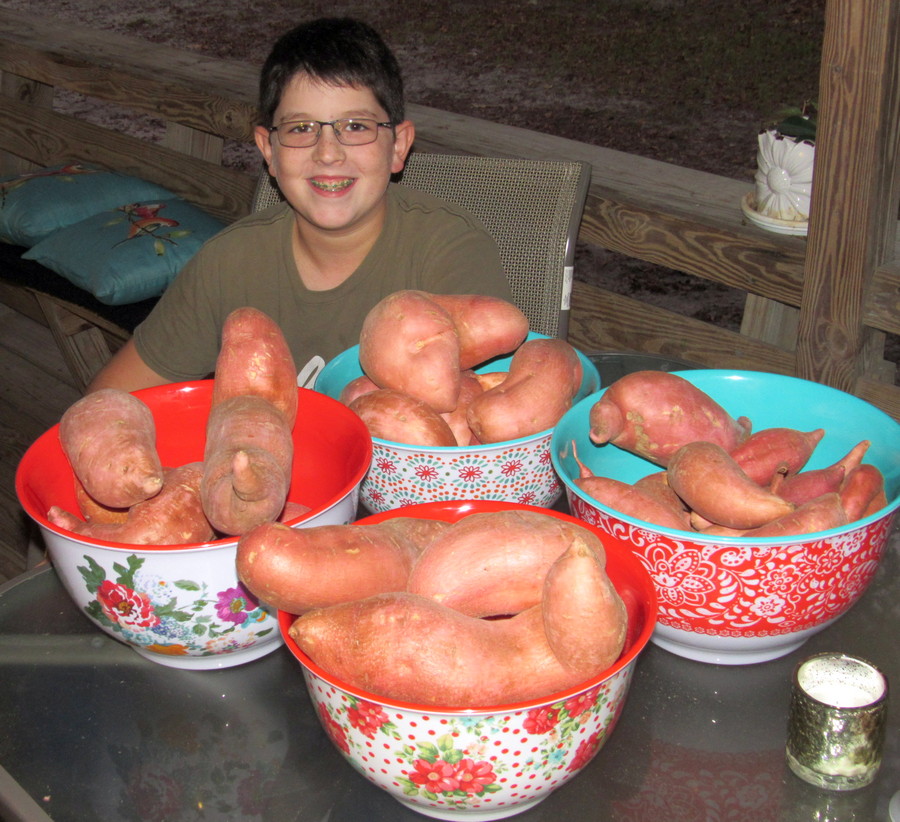
Farmer Jerry (Willis & Debby’s 2nd born) with sweet potatoes he grew in his garden!
24 Gabriel Road
Lodge, South Carolina 29082
Happy Thanksgiving!
843 846 2500

November 2018
Number 57
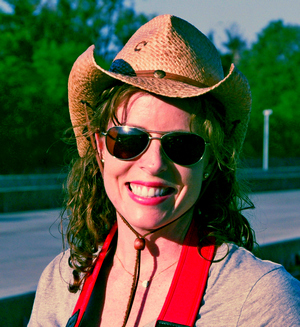 From the desk
From the desk
of Abbey …
Thanksgiving always reminds me how very fortunate I am to know so many nice people. Many of you have become dear friends and I look forward to work each day because of you! I hope you enjoy a wonderful Thanksgiving celebration – surrounded by love, laughter and family!
I wanted to share a couple of the websites that I have found recently. Being from a large family you can imagine what fun it is to try and find a special gift for everyone and not feel like I am buying all my nieces and nephews the same thing! I am sure you are familiar with some of the web sites but I hope there is at least one or more that inspires you and helps you find the perfect gift for a loved one!
Sweetest baby gifts:
https://www.bunniesbythebay.com
Especially love the home and sale items for unique gifts for myself (!) or others:
One of my all time favorite websites for friends and family of all ages:
Fabulous local and handmade jewelry:
Pretty, local clothing, accessories and jewelry:
https://www.colbertclothing.com
Patriotic gifts for the whole family
https://www.ninelineapparel.com
As many of you know we enjoy the luxury of fresh eggs. Willis’ children care for the chickens. They track the egg intake, calculate the cost of the feed and use the income from eggs to buy more feed. If any of you are interested in purchasing fresh farm eggs please feel free to ask!
My youngest sister, Jessy, has started selling her clothing and accessory items at “Twig”, a store on Washington Street in downtown Walterboro. The store has a wide assortment of more than just clothing and accessories so something is sure to catch your eye! Stop in and say “hi” next time you are close, she would love to meet you and show you around! Jessy has taken over practically all of the book work for me and does that around working a few days a week at Twig.
Mandy, my second youngest sister, is going to start refinishing pieces of furniture to sell at “Twig”! There is a lady showing her the ins and outs of custom faux refinishing and she has already completed her first piece! If you have any pieces of furniture that you would like to transform into an “antique” she may be able to help!
As always, Willis’ older boys, Henry and Jerry, love having their woodworking projects! They have built chicken houses, benches, storage containers and even a jewelry box for one of their younger sisters! Their daddy is strict with how things look when they are done. If you have a small project you would like them to build for you I am sure they would love to help!
I want to wish you all the best this rapidly approaching holiday season. May you all have the best year yet in 2019!
How Do Septic Systems Work?
Septic systems are not the most pleasant of subjects, but it is good to have a basic understanding of them.
The simplest septic system has a tank and a drain field.
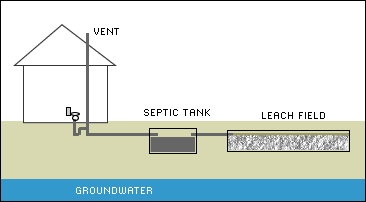
A simple septic system.
The drains of all plumbing fixtures in your home tie together and are routed to a septic tank (or sewer). Each fixture has a “trap”, a low place where water is trapped (hence the name). In order to keep the water in the trap from being siphoned out of the trap, a vent pipe past the trap allows air into the pipe to break a siphon so sewer gases are kept out of your home.
If you allow the water in the traps to evaporate (by not using a fixture an extended time), you will get unpleasant smells. Fortunately, the fix for water that has evaporated from the traps is easy: just run more water in them.
The large pipes going through the roof of your home are plumbing vent pipes. Plumbers tie as many vents together as they can to minimize the number of pipes going through your roof.
Waste water flows from your home through a septic tank and then to a drain field. The purpose of the septic tank is to separate oils, solids and liquids.
A septic tank is basically a large (often 1,000 gallon) tank. It may be concrete, fiberglass or heavy plastic.
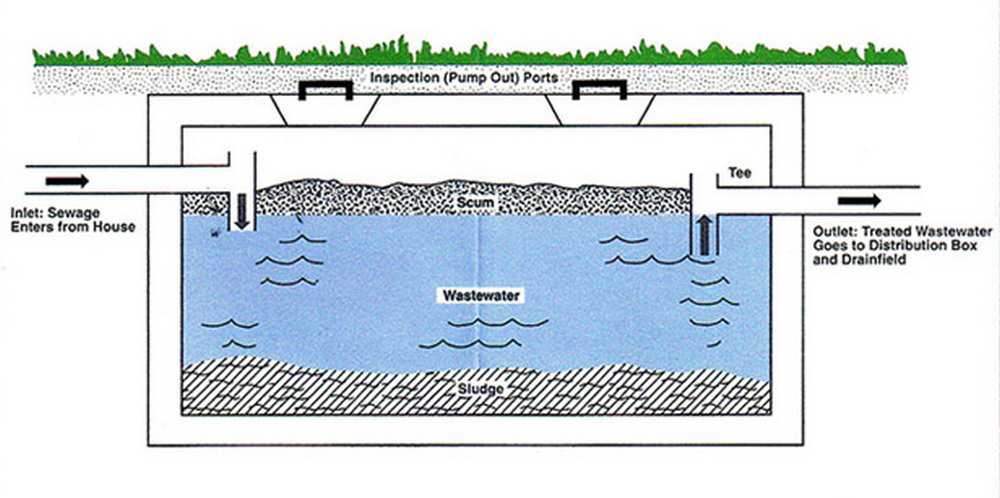
A septic tank schematic
Waste water from the house enters the tank on the left in this schematic. The tee is on the inlet pipe so waste water is forced to go down into the blue area.
In the blue area, the oil and grease floats to the top (scum) and the solid matter sinks to the bottom (sludge).
The waste water (less the scum and sludge) collects in the tank. When it gets high enough, it flows out the right side of the tank. There is a tee there to block the scum from flowing out.
The wastewater in the tank contains a lot of anaerobic bacteria that feeds off the solid matter in the tank. The bacteria breaks down the organic material in the wastewater. Because this bacteria is slow acting, the tanks have to be large so it takes a while for wastewater to pass through the tank. Generally, about 40% of the organic matter is treated in the tank.
Waste water (effluent) then flows out the right side of the tank and to the drain field. Often, there is a distribution box where several branches of the drain field are connected. In the drain field, the remaining organic matter is treated by the bacteria.
The existence of the bacteria in the septic system to treat organic matter is the reason you have to be careful what you put down the drain. If you put something down the drain that kills bacteria, your tank will fail.
Typically water flows into the tank and drain field by gravity. In cases where the tank and/or drain field cannot be placed where gravity will make the water flow, pumps have to be used. The pumps are put in large holding tanks.
Sometimes a tank between the septic tank and the drain field is added to help insure the effluent has little scum or sludge in it.
Once the effluent makes it to the drain field, it percolates down into the ground. The effluent is cleaned as it flows down to the water table.
If you happen to live in an area where the soil does not “perk” (i.e., it is very wet), you may need a raised drain field so the effluent can flow out of the drain field.
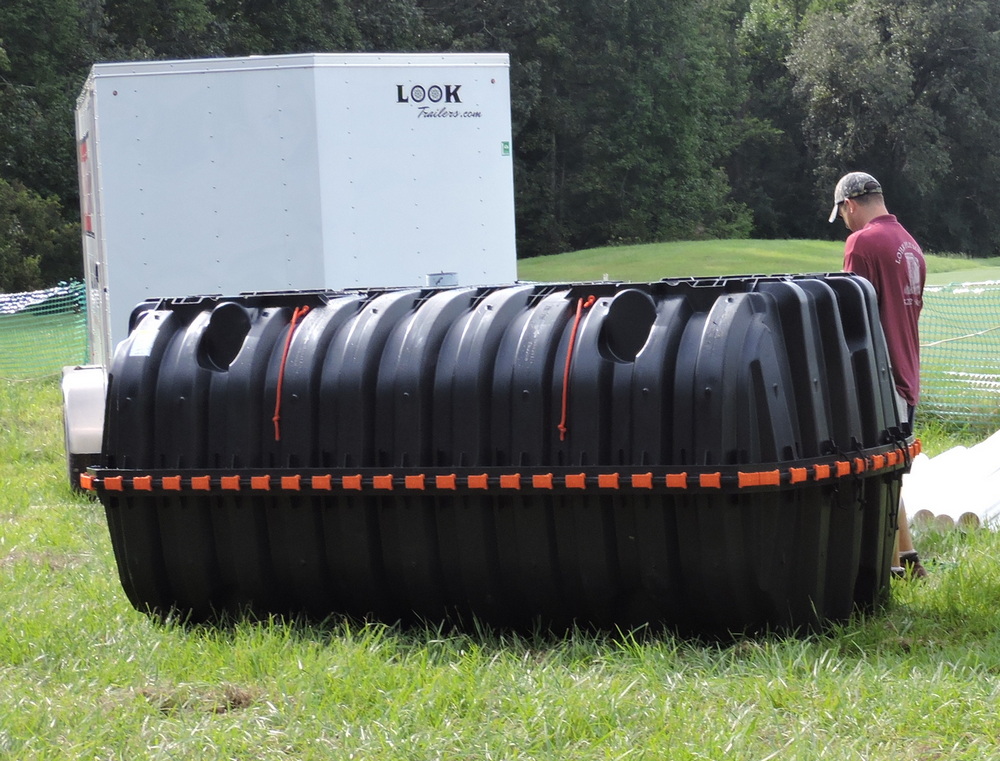
This is an ABS 1000 gallon septic tank we recently installed. Notice the physical size compared to the plumber who is over six feet tall.
Potential problems
One problem has already been mentioned: destroying the bacterial action in the tank so the harmful bacteria are not treated. If you look at items you purchase that could wind up in a septic tank (cleaners and such), they will often say “safe for septic systems” assuring you they won’t kill the bacteria.
Another problem is if the scum level gets too high (because the tank has not been pumped), it will overflow the tee and go to the drain field. Should scum does make it to the drain field (which is made of pipes with holes in them), the scum will plug the holes and cause your drain field to be plugged. The solution is to dig it up and install another or abandon it and install a new one.
It is important to pump your septic system on a regular basis (depending on usage). Typically every few years. Notice on the schematic, there are inspection ports located at the “lids”. These are used to pump the tank.
Another potential problem is flushing items that will not decompose in a reasonable time. Some oily tissues won’t decompose. Wipes (such as Clorox® wipes) won’t decompose. If those items are flushed, they will collect in the tank (pump or septic) until they clog up the system.
As always, please call if you have any questions or need any assistance. We can help!
Willis Sinclair Homes
Our goal is your complete satisfaction!
Call Us

843 846 2500





No Comments